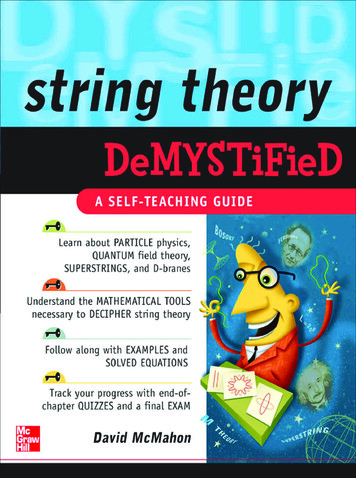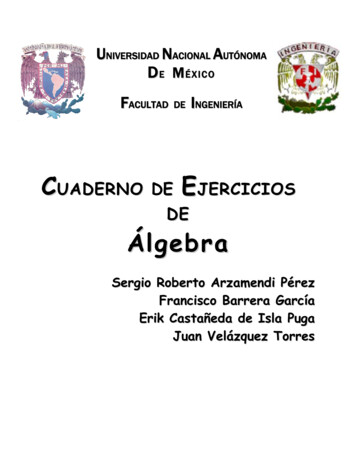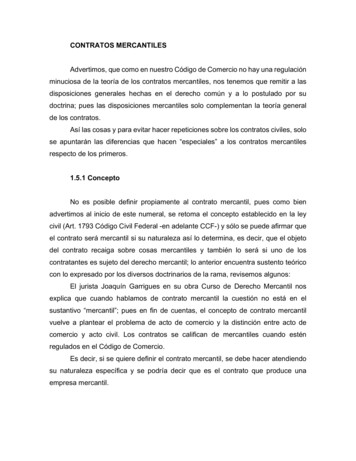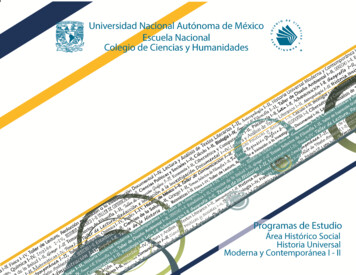
Transcription
Demystified SeriesAccounting DemystifiedAdvanced Calculus DemystifiedAdvanced Physics DemystifiedAdvanced Statistics DemystifiedAlgebra DemystifiedAlternative Energy DemystifiedAnatomy DemystifiedAstronomy DemystifiedAudio DemystifiedBiochemistry DemystifiedBiology DemystifiedBiotechnology DemystifiedBusiness Calculus DemystifiedBusiness Math DemystifiedBusiness Statistics DemystifiedC DemystifiedCalculus DemystifiedChemistry DemystifiedCircuit Analysis DemystifiedCollege Algebra DemystifiedComplex Variables DemystifiedCorporate Finance DemystifiedDatabases DemystifiedDiabetes DemystifiedDifferential Equations DemystifiedDigital Electronics DemystifiedDiscrete Mathematics DemystifiedEarth Science DemystifiedElectricity DemystifiedElectronics DemystifiedEngineering Statistics DemystifiedEnvironmental Science DemystifiedEveryday Math DemystifiedFertility DemystifiedFinancial Planning DemystifiedForensics DemystifiedFrench DemystifiedGenetics DemystifiedGeometry DemystifiedGerman DemystifiedGlobal Warming and Climate Change DemystifiedHedge Funds DemystifiedInvesting DemystifiedItalian DemystifiedJava DemystifiedJavaScript DemystifiedLean Six Sigma DemystifiedLinear Algebra DemystifiedMacroeconomics DemystifiedManagement Accounting DemystifiedMath Proofs DemystifiedMath Word Problems DemystifiedMATLAB DemystifiedMedical Billing and Coding DemystifiedMedical Charting DemystifiedMedical-Surgical Nursing DemystifiedMedical Terminology DemystifiedMeteorology DemystifiedMicrobiology DemystifiedMicroeconomics DemystifiedNanotechnology DemystifiedNurse Management DemystifiedOOP DemystifiedOptions DemystifiedOrganic Chemistry DemystifiedPharmacology DemystifiedPhysics DemystifiedPhysiology DemystifiedPre-Algebra DemystifiedPrecalculus DemystifiedProbability DemystifiedProject Management DemystifiedPsychology DemystifiedQuantum Field Theory DemystifiedQuantum Mechanics DemystifiedReal Estate Math DemystifiedRelativity DemystifiedRobotics DemystifiedSales Management DemystifiedSignals and Systems DemystifiedSix Sigma DemystifiedSpanish DemystifiedSQL DemystifiedStatics and Dynamics DemystifiedStatistics DemystifiedString Theory DemystifiedTechnical Analysis DemystifiedTechnical Math DemystifiedTrigonometry DemystifiedVitamins and Minerals Demystified
String TheoryDemystifiedDavid McMahonNew York Chicago San Francisco Lisbon LondonMadrid Mexico City Milan New Delhi San JuanSeoul Singapore Sydney Toronto
Copyright 2009 by The McGraw-Hill Companies, Inc. All rights reserved. Manufactured in the United States of America. Exceptas permitted under the United States Copyright Act of 1976, no part of this publication may be reproduced or distributed in any formor by any means, or stored in a database or retrieval system, without the prior written permission of the publisher.0-07-159620-8The material in this eBook also appears in the print version of this title: 0-07-149870-2.All trademarks are trademarks of their respective owners. Rather than put a trademark symbol after every occurrence of atrademarked name, we use names in an editorial fashion only, and to the benefit of the trademark owner, with no intention ofinfringement of the trademark. Where such designations appear in this book, they have been printed with initial caps.McGraw-Hill eBooks are available at special quantity discounts to use as premiums and sales promotions, or for use in corporatetraining programs. For more information, please contact George Hoare, Special Sales, at george hoare@mcgraw-hill.com or (212)904-4069.TERMS OF USEThis is a copyrighted work and The McGraw-Hill Companies, Inc. (“McGraw-Hill”) and its licensors reserve all rights in and to thework. Use of this work is subject to these terms. Except as permitted under the Copyright Act of 1976 and the right to store andretrieve one copy of the work, you may not decompile, disassemble, reverse engineer, reproduce, modify, create derivative worksbased upon, transmit, distribute, disseminate, sell, publish or sublicense the work or any part of it without McGraw-Hill’s prior consent. You may use the work for your own noncommercial and personal use; any other use of the work is strictly prohibited. Your rightto use the work may be terminated if you fail to comply with these terms.THE WORK IS PROVIDED “AS IS.” McGRAW-HILL AND ITS LICENSORS MAKE NO GUARANTEES OR WARRANTIESAS TO THE ACCURACY, ADEQUACY OR COMPLETENESS OF OR RESULTS TO BE OBTAINED FROM USING THEWORK, INCLUDING ANY INFORMATION THAT CAN BE ACCESSED THROUGH THE WORK VIA HYPERLINK OR OTHERWISE, AND EXPRESSLY DISCLAIM ANY WARRANTY, EXPRESS OR IMPLIED, INCLUDING BUT NOTLIMITED TO IMPLIED WARRANTIES OF MERCHANTABILITY OR FITNESS FOR A PARTICULAR PURPOSE. McGrawHill and its licensors do not warrant or guarantee that the functions contained in the work will meet your requirements or that itsoperation will be uninterrupted or error free. Neither McGraw-Hill nor its licensors shall be liable to you or anyone else for anyinaccuracy, error or omission, regardless of cause, in the work or for any damages resulting therefrom. McGraw-Hill has no responsibility for the content of any information accessed through the work. Under no circumstances shall McGraw-Hill and/or its licensors be liable for any indirect, incidental, special, punitive, consequential or similar damages that result from the use of or inabilityto use the work, even if any of them has been advised of the possibility of such damages. This limitation of liability shall apply toany claim or cause whatsoever whether such claim or cause arises in contract, tort or otherwise.DOI: 10.1036/0071498702
ProfessionalWant to learn more?We hope you enjoy thisMcGraw-Hill eBook! Ifyou’d like more information about this book,its author, or related books and websites,please click here.
For more information about this title, click hereCONTENTSPrefacexiCHAPTER 1IntroductionA Quick Overview of General RelativityA Quick Primer on Quantum TheoryThe Standard ModelQuantizing the Gravitational FieldSome Basic Analysis in String TheoryUnification and Fundamental ConstantsString Theory OverviewSummaryQuiz123881011121818CHAPTER 2The Classical String I: Equations of MotionThe Relativistic Point ParticleStrings in Space-TimeEquations of Motion for the StringThe Polyakov ActionMathematical Aside: The Euler CharacteristicLight-Cone CoordinatesSolutions of the Wave EquationOpen Strings with Free EndpointsClosed Strings21222832363639434446
viString Theory DemystifiedOpen Strings with Fixed EndpointsPoisson BracketsQuiz474949The Classical String II: Symmetries andWorldsheet CurrentsThe Energy-Momentum TensorSymmetries of the Polyakov ActionTransforming to a Flat Worldsheet MetricConserved Currents from Poincaré InvarianceThe HamiltonianSummaryQuiz5152535963676767CHAPTER 4String QuantizationCovariant QuantizationLight-Cone QuantizationSummaryQuiz6970858787CHAPTER 5Conformal Field Theory Part IThe Role of Conformal Field Theoryin String TheoryWick RotationsComplex CoordinatesGenerators of Conformal TransformationsThe Two-Dimensional Conformal GroupCentral ExtensionClosed String Conformal Field TheoryWick ExpansionOperator Product 4BRST QuantizationBRST Operators and Introductory RemarksBRST-Invariant States115116118CHAPTER 3CHAPTER 6
viiContentsBRST in String Theory-CFTBRST TransformationsNo-Ghost TheoremSummaryQuiz120121125125126CHAPTER 7RNS SuperstringsThe Superstring ActionConserved CurrentsThe Energy-Momentum TensorMode Expansions and Boundary ConditionsSuper-Virasoro GeneratorsCanonical QuantizationThe Super-Virasoro AlgebraThe Open String SpectrumGSO ProjectionCritical 149150150CHAPTER 8Compactification and T-DualityCompactification of the 25th DimensionModified Mass SpectrumT-Duality for Closed StringsOpen Strings and 65CHAPTER 9Superstring Theory ContinuedSuperspace and SuperfieldsSuperfield for Worldsheet SupersymmetryGrassman IntegrationA Manifestly Supersymmetric ActionThe Green-Schwarz ActionSpace-Time Supersymmetry and Strings167168171173174175180
viiiString Theory DemystifiedLight-Cone GaugeCanonical QuantizationSummaryQuiz181184185186CHAPTER 10A Summary of Superstring TheoryA Summary of Superstring TheorySuperstring TheoryDualitiesQuiz187187190192193CHAPTER 11Type II String TheoriesThe R and NS SectorsThe Spin FieldType II A String TheoryType II B TheoryThe Massless Spectrum of Different SectorsSummaryQuiz195195200201203203204205CHAPTER 12Heterotic String TheoryThe Action for SO(32) TheoryQuantization of SO(32) TheoryThe SpectrumCompactification and Quantized MomentumSummaryQuiz207208209214216219219CHAPTER 13D-BranesThe Space-Time ArenaQuantizationD-Branes in Superstring TheoryMultiple D-BranesTachyons and D-Brane DecaySummaryQuiz221223225230230235237237
ContentsCHAPTER 14CHAPTER 15CHAPTER 16ixBlack HolesBlack Holes in General RelativityCharged Black HolesThe Laws of Black Hole MechanicsComputing the Temperature of a Black HoleEntropy Calculations for Black Holeswith String TheorySummaryQuizThe Holographic Principle and AdS/CFTCorrespondenceA Statement of the Holographic PrincipleA Qualitative Description of AdS/CFTCorrespondenceThe Holographic Principle and M-TheoryMore 55256257258260262262String Theory and CosmologyEinstein’s EquationsInflationThe Kasner MetricThe Randall-Sundrum ModelBrane Worlds and the Ekpyrotic UniverseSummaryQuiz265266266268273275277278Final Exam279Quiz Solutions285Final Exam Solutions291References297Index299
ABOUT THE AUTHORDavid McMahon has worked for several years as a physicist and researcher atSandia National Laboratories. He is the author of Linear Algebra Demystified,Quantum Mechanics Demystified, Relativity Demystified, MATLAB Demystified, andComplex Variables Demystified, among other successful titles.Copyright 2009 by The McGraw-Hill Companies, Inc. Click here for terms of use.
PREFACEString theory is the greatest scientific quest of all time. Its goal is nothing other thana complete description of physical reality—at least at the level of fundamentalparticles, interactions, and perhaps space-time itself. In principle, once thefundamental theory is fully known, one could derive relativity and quantum theoryas low-energy limits to strings. The theory sets out to do what no other has beenable to since the early twentieth century—combine general relativity and quantumtheory into a single unified framework. This is an ambitious program that hasoccupied the best minds in mathematics and physics for decades. Einstein himselffailed, but he lacked key ingredients that are necessary to pull it off.String theory comes attached with a bit of controversy. As anyone who is readingthis book likely knows, experimentally testing it is not an immediately accessibleoption due to the high energies required. It is, after all, a theory of creation itself—so the energies associated with string theory are of course very large. Nonetheless,it now appears that some indirect tests are possible and the timing of this book maycoincide with some of this program. The first clue will be the continued search forsupersymmetry, the theory that proposes fermions and bosons have superpartners,that is, a fermion like an electron has a sister superpartner particle that is a boson.Superparticles have not been discovered, so if it exists supersymmetry must bebroken somehow so that the super partners have high mass. This could explain whywe haven’t seen them so far. But the Large Hadron Collider being constructed inEurope as we speak may be able to discover evidence of supersymmetry. This doesnot prove string theory, because you can have supersymmetry work just fine withpoint particles. However, supersymmetry is absolutely essential for string theory towork. If supersymmetry does not exist, string theory cannot be true. If supersymmetryis found, while it does not prove string theory, it is a good indication that stringtheory might be right.Recent theoretical work also opens up the intriguing possibility that there mightbe large extra dimensions and that they might be inferred in experimental tests.Only gravity can travel into the extra space scientists call the “bulk.” At the energiesof the Large Hadron Collider, it might be possible to see some evidence that this isCopyright 2009 by The McGraw-Hill Companies, Inc. Click here for terms of use.
xiiString Theory Demystifiedhappening, and some have even proposed that microscopic black holes could beproduced. Again, you could imagine having extra dimensions without string theory,so discoveries like these would not prove string theory. However, they would bemajor indirect evidence in its favor. You will learn in this book that string theorypredicts the existence of extra dimensions, so any evidence of this has to be takenas a serious indication that string theory is on the right path.String theory has lots of problems—it’s a work in progress. This time is akin toliving in the era when the existence of atoms was postulated but unproven andskeptics abounded. There are lots of skeptics out there. And string theory does seema bit crazy—there are several versions of the theory, and each has a myriad ofparticle states that have not been discovered (however, note that transformationscalled dualities have been discovered that relate the different string theories, andwork is underway on an underlying theory believed to exist called M-theory). Theonly serious competitor right now for string theory is loop quantum gravity. I wantto emphasize I am not an expert, but I once took a seminar on it and to be honest Ifound it incredibly distasteful. It seemed so abstract it almost didn’t seem likephysics at all. It struck me more as mathematical philosophy. String theory seems alot more physical to me. It makes outlandish predictions like the existence of extradimensions, but general relativity and quantum theory make predictions that defycommon sense as well. Eventually, all we can do is hope that experiment andobservation will resolve the controversy and help us decide if loop quantum gravityor string theory is on the right track. Regardless of what our tastes are, since this isscience we will have to follow where the evidence leads.This book is written with the intent of getting readers started in string theory. Itis intended for self-study and to make the real textbooks on the subject moreaccessible after you finish this one.But make no mistake: This is not a “popular” book—it is written for readers whowant to learn string theory.The presentation has been simplified in some places. I have left out importanttopics like path integration, differential forms, and partition functions that arenecessary for advanced study. Even so, there has been an attempt to give the readera good overview of the basics of string physics. Unlike other introductory texts, Ihave decided to include a discussion of superstrings. It is more complicated, but myfeeling is if you understand the bosonic case it’s not too much of a leap to includesuperstrings. What you really need as background for this is some exposure to Diracspinors. If you don’t have this background, read Griffiths’ Elementary Particles ortry Quantum Field Theory Demystified. The bottom line is that string theory is anadvanced topic, so you will need to have the background before reading this book.Specifically, from mathematics you need to know calculus, linear algebra, and partialand ordinary differential equations. It also helps to know some complex variables,and my book Complex Variables Demystified is being released at about the same
Prefacexiiitime as this one to help you with this. This sounds like a long list and if you’re juststarting out it is. But you don’t have to be an expert—just get a grasp of the topicsand you should do fine with this book.From physics, you should start off with wave motion if you’re rusty with it. Openup a freshman physics book to do this. The core concepts you need for string theoryare going to include wave motion on a string, boundary conditions on a string (frombasic partial differential equations), the harmonic oscillator from quantummechanics, and special relativity. Brush up on these before attempting to read thisbook. Due to limited space in the book, I did not include all of the backgroundmaterial from ground zero like Zweibach does in his fine text. I have attempted topresent as accessible a presentation as possible but assume you already have donesome background study. The three areas you need are quantum mechanics, relativity,and quantum field theory. Luckily there are three Demystified books available onthese topics if you haven’t studied them elsewhere.In the short space allotted for a Demystified book, we can’t cover everythingfrom string theory. I have tried to strike a balance between building the basic physicsand laying down the necessary mathematical machinery and being too advancedand introducing the most exciting topics. Unfortunately, this is not an easy programto pull off. I cover bosonic strings, superstrings, D-branes, black hole physics, andcosmology, among other topics. I have also included a discussion of the RandallSundrum model and how it resovles the hierarchy problem from particle physics.I want to conclude by recommending Michio Kaku’s popular physics books. Iwas actually “converted” from engineering to physics by reading one of his booksthat introduced me to the amazing world of string theory. It’s hard to believe thatpicking up one of Kaku’s books would have led me on a path such that I ended upwriting a book on string theory. In any case, good luck on your quest to understandthe universe, and I hope that this book makes that task more accessible to you.David McMahon
This page intentionally left blank
CHAPTER 1IntroductionGeneral relativity and quantum mechanics stand out as the pillars of twentiethcentury science, able to describe almost all known phenomena from the scale ofsubatomic particles all the way up to the rotations of galaxies and even the historyof the universe itself. Despite this grand success, which includes stunning agreementwith experiment, these two theories represent physics at a crossroads—one that isplagued with crisis and controversy.The problem is that at first sight, these two theories are at complete odds witheach other. The general theory of relativity (GR), Einstein’s crowning achievement,describes gravitational interactions, that is, interactions that occur on the largestscales that we know. But it not only stands out as Einstein’s greatest contribution toscience but it also might be called the last classical theory of physics. That is,despite its revolutionary nature, GR does not take quantum mechanics into accountat all. Since experiment indicates that quantum mechanics is the correct descriptionfor the behavior of matter, this is a serious flaw in the theory of general relativity.We don’t think about this under normal circumstances because quantum effectsonly become important in gravitational interactions that are extremely strong ortaking place over very small scales. In the situations where we might apply generalrelativity, say to the motion of the planet mercury around the sun or the motion ofCopyright 2009 by The McGraw-Hill Companies, Inc. Click here for terms of use.
2String Theory Demystifiedthe galaxies, quantum effects are not important at all. Two places where they willbe important are in black hole physics and in the birth of the universe. We mightalso see quantum effects on gravity in very high energy particle interactions.On the other hand, quantum mechanics basically ignores the insights of relativity.It basically pretends gravity doesn’t exist at all, and pretends that space and time arenot on the same footing. The notion of space-time does not enter in quantummechanics, and although special relativity plays a central role in quantum fieldtheory, gravitational interactions are nowhere to be found there either.A Quick Overview of General RelativityThis isn’t a book on GR, but we can give a very brief overview of the theory here(see Relativity Demystified for details). The central ideas of general relativity arethe notion that geometry is dynamic and that the speed of light limits the speed ofall interactions, including gravity. We start with the notion of the metric, which isa way of describing the distance between two points. In ordinary three-dimensionalspace the metric isds 2 dx 2 dy 2 dz 2(1.1)This metric follows from the pythagorean theorem by making the distancesinvolved infinitesimal. Note that this metric is invariant under rotations. Somethingthat is key to relativistic thinking is focusing on those quantities that are invariant.To move up to a relativistic context, we extend the notion of a measure of distancebetween two points to a notion of distance between two events that happen in spaceand time. That is, we measure the distance between two points in space-time. Thisis done with the metricds 2 c 2 dt 2 dx 2 dy 2 dz 2(1.2)This metric extends the idea of geometry to include time as well. But not only that,it also extends the notion of a distance measure between two points that is invariantunder rotations to one that is also invariant under Lorentz transformations, that is,Lorentz boosts between one inertial frame and another.While adding time to the mix certainly extends the notion of geometry into anunfamiliar realm, we still have a fixed geometry that does not take into accountgravitational fields. To extend the metric in a way that will do this, we have to enterthe domain of non-euclidean geometry. This is geometry which does not require
CHAPTER 1 Introduction3flat spaces. Instead we generalize to include spaces that are curved, like spheres orsaddles. Now, since we are in a relativistic context, we need to include not justcurved spaces but time as well, so we work with curved space-time. A general wayto write Eq. (1.2) that will do this for us isds 2 gµν ( x )dx µ dxν(1.3)The metric tensor is the object gµν ( x ), which has components that depend onspace-time. Now we have a dynamical geometry that varies from place to place andfrom time to time, and it turns out that gµν ( x ) is directly related to the gravitationalfield. Hence we arrive at the central truth of general relativity:gravitygeometryGravitational fields are essentially the geometry of space-time. The form of themetric tensor gµν ( x ) actually stems from the matter—energy that is present in agiven region of space-time—which is the way that matter is the source of thegravitational field. The presence of matter alters the geometry, which changes thepaths of free-falling particles giving the appearance of a gravitational field.The equation that relates matter and geometry (i.e., the gravitational field) iscalled Einstein’s equation. It has the form1Rµν gµν R 8π GTµν2(1.4)where G 6.673 10 4 m 3 / kg s 2 is Newton’s constant of gravitation and Tµν is theenergy-momentum tensor. Rµν and R are objects that depend on the derivatives ofthe metric tensor gµν ( x ) and hence represent the dynamic nature of geometry inrelativity. The energy-momentum tensor Tµν tells us how much energy and matteris present in the space-time region being considered. The details of the equation arenot important for our purposes, just keep in mind that matter (and energy) changethe geometry of space-time giving rise to what we call a gravitational field, bychanging the paths followed by free particles.A Quick Primer on Quantum TheorySo matter enters the theory of relativity through the energy-momentum tensor Tµν.The rub is that we know that matter behaves according to the laws of quantumtheory, which are at odds with the general theory of relativity. Without going into
String Theory Demystified4detail, we will review the basic ideas of quantum mechanics in this section (seeQuantum Mechanics Demystified for a detailed description). In quantum mechanics,everything we could possibly find out about a particle is contained in the state of theparticle or system described by a wave function:ψ ( x, t )The wave function is a solution of Schrödinger’s equation:2 2m 2ψ Vψ i ψ t(1.5)The wave function itself is not a real physical wave, rather it is a probability2amplitude whose modulus squared ψ ( x, t ) (note that the wave function can becomplex) gives the probability that the particle or system is found in a givenstate.Measurable observables like position and momentum are promoted tomathematical operators in quantum mechanics. They act on states (i.e., on wavefunctions) and must satisfy certain commutation rules. For example, position andmomentum satisfy[ x, p ] i(1.6)Furthermore, there exists an uncertainty principle that puts constraints on theprecision with which certain quantities can be known. Two important examples are x p / 2 E t / 2(1.7)So the more precisely we know the momentum of a particle, the less certain we areof its position and vice versa. The smaller the interval of time over which weexamine a physical process, the greater the fluctuations in energy.When considering a system with multiple particles, we have a wave functionψ ( x1 , x 2 , , x n ) say where there are n particles with coordinates xi . It turns outthat there are two basic types of particles depending on how the wave functionbehaves under particle interchange xix j . Considering the two-particle case forsimplicity, if the sign of the wave function is unchanged underψ ( x1 , x2 ) ψ ( x2 , x1 )
CHAPTER 1 Introduction5we say that the particles are bosons. Any number of bosons can exist in the samequantum state. On the other hand, if the exchange of two particles induces a minussign in the wave functionψ ( x1 , x2 ) ψ ( x2 , x1 )then we say that the particles in question are fermions. Fermions obey a constraintknown as the Pauli exclusion principle, which says that no two fermions can occupythe same quantum state. So while boson number can assume any value nb 0, , the number of fermions that can occupy a quantum state is 0 or 1, that is, n f 0, 1and not any other value.The first move at bringing quantum theory and relativity together in the sameframework is done by combining quantum mechanics together with the specialtheory of relativity (and hence leaving gravity out of the picture). The result, calledquantum field theory, is a spectacular scientific success that agrees with all knownexperimental tests (see Quantum Field Theory Demystified for more details). Inquantum field theory, space-time is filled with fields ϕ ( x , t ) that act as operators. Agiven field can be Fourier expanded asϕ (x) d 3k(2π )3/ 2 ϕ ( k )e i (ω k x2ω k 0 k x ) ϕ * ( k )ei (ω k x0 k x ) We then express the fields in terms of creation and annihilation operators by makingthe transition ϕ ( k ) aˆ ( k ) and ϕ * ( k ) aˆ † ( k ) givingϕˆ ( x ) d 3k(2π )3/ 2 aˆ ( k )e i (ω k x2ω k 0 k x ) aˆ † ( k )ei (ω k x0 k x ) The field then creates and destroys particles that are the quanta of the given field.We require that all quantities be Lorentz invariant. To get quantum theory moreinto the picture, we impose commutation relations on the fields and their conjugatemomenta[ϕˆ ( x ), πˆ ( y)] iδ ( x y)[ϕˆ ( x ), ϕˆ ( y)] 0[πˆ ( x ), πˆ ( y)] 0
String Theory Demystified6The interaction occurs at a singlepoint in space-timeTwo particlescome in tointeractFigure 1.1In particle physics, interactions occur at a single point.where πˆ ( x ) is the conjugate momenta obtained from the field ϕ ( x, t ) using standardtechniques from lagrangian mechanics.From the commutation relations and from the form of the fields (i.e., the creationand annihilation operators) you might glean that particle interactions take place atspecific, individual points in space-time. This is important because it means thatparticle interactions take place over zero distance. Particles in quantum field theoryare point particles represented mathematically as located at a single point. This isillustrated schematically in Fig. 1.1.Now, calculations in quantum field theory can be done using a perturbativeexpansion. Each term in the expansion describes a possible particle interaction and itcan be represented graphically using a Feynman diagram. For example, in Fig. 1.2,we see two electrons scattering off each other.The Feynman diagram in Fig. 1.2 represents the lowest-order term in the seriesdescribing the amplitude for the process to occur. Taking more terms in the series,we add diagrams with more complex internal interactions that have the sameeeγeFigure 1.2eA Feynman diagram illustrating the scattering of two electrons.
CHAPTER 1 Introduction7eeγeeFigure 1.3The photon turns into an electron-positron pair (the circle) thatsubsequently annihilate producing another photon.initial and final states. For example, the exchanged photon might turn into anelectron-positron pair, which subsequently decays into another photon. This isillustrated in Fig. 1.3.Interior processes like that shown in Fig. 1.3 are called virtual. This is becausethey do not appear as initial or final states. To find the actual amplitude for a givenprocess to occur, we need to draw Feynman diagrams for every possible virtualprocess, that is, take all the terms in the series. In practice we can take only as manyterms as we need to get the accuracy desired in our calculations.This type of procedure works well in the electromagnetic, weak, and stronginteractions. However, the overall procedure has some big problems and theycannot be dealt with when gravity is involved. The problem comes down to the factthat interactions occur at a single space-time point. This leads to infinite results incalculations (aptly called infinities). Technically speaking, the calculation of agiven amplitude which inc
Six Sigma Demystified Spanish Demystified SQL Demystified Statics and Dynamics Demystified Statistics Demystified String Theory Demystified Technical Analysis Demystified Technical Math Demystified Trigonometry Demystified Vitamins and Mineral










